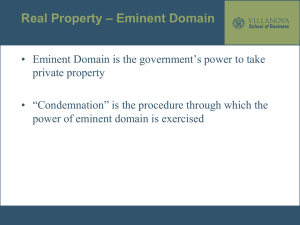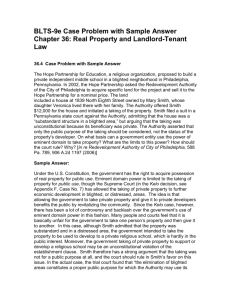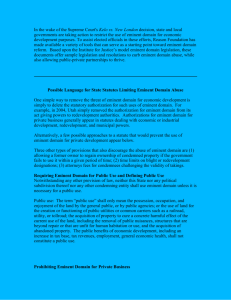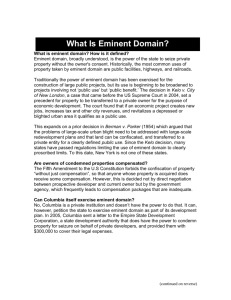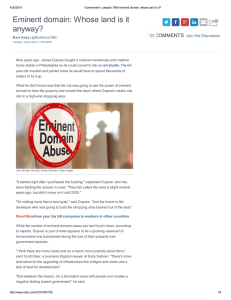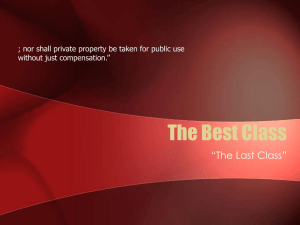Power of Eminent Domain
advertisement
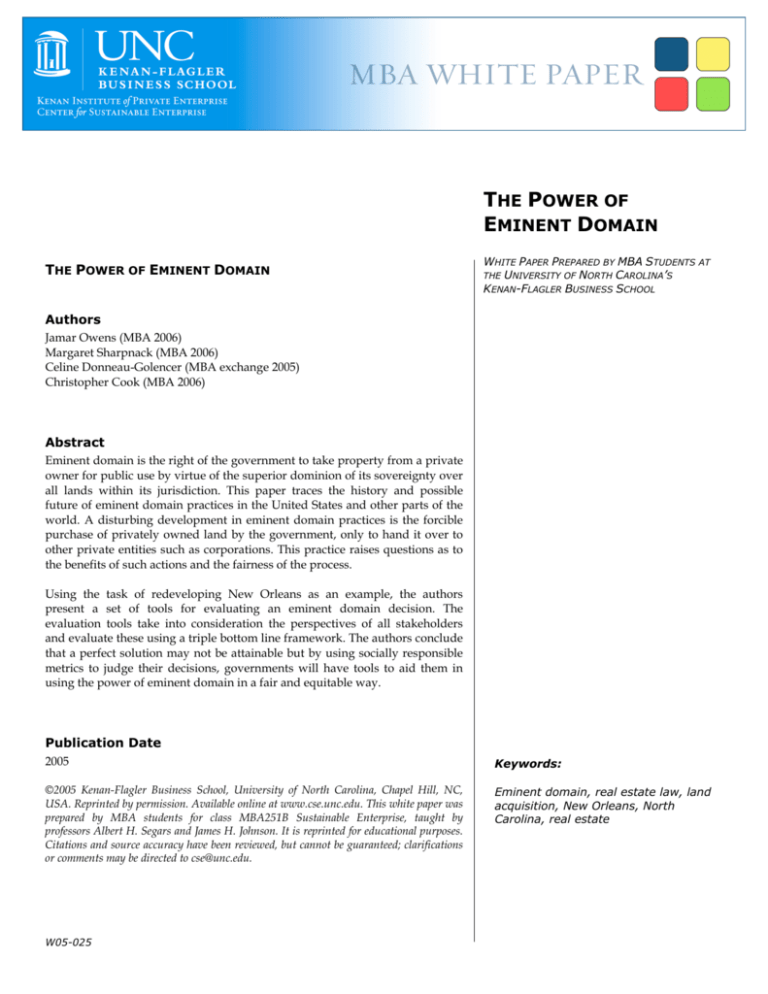
THE POWER OF EMINENT DOMAIN THE POWER OF EMINENT DOMAIN WHITE PAPER PREPARED BY MBA STUDENTS AT UNIVERSITY OF NORTH CAROLINA’S KENAN-FLAGLER BUSINESS SCHOOL THE Authors Jamar Owens (MBA 2006) Margaret Sharpnack (MBA 2006) Celine Donneau-Golencer (MBA exchange 2005) Christopher Cook (MBA 2006) Abstract Eminent domain is the right of the government to take property from a private owner for public use by virtue of the superior dominion of its sovereignty over all lands within its jurisdiction. This paper traces the history and possible future of eminent domain practices in the United States and other parts of the world. A disturbing development in eminent domain practices is the forcible purchase of privately owned land by the government, only to hand it over to other private entities such as corporations. This practice raises questions as to the benefits of such actions and the fairness of the process. Using the task of redeveloping New Orleans as an example, the authors present a set of tools for evaluating an eminent domain decision. The evaluation tools take into consideration the perspectives of all stakeholders and evaluate these using a triple bottom line framework. The authors conclude that a perfect solution may not be attainable but by using socially responsible metrics to judge their decisions, governments will have tools to aid them in using the power of eminent domain in a fair and equitable way. Publication Date 2005 Keywords: ©2005 Kenan-Flagler Business School, University of North Carolina, Chapel Hill, NC, USA. Reprinted by permission. Available online at www.cse.unc.edu. This white paper was prepared by MBA students for class MBA251B Sustainable Enterprise, taught by professors Albert H. Segars and James H. Johnson. It is reprinted for educational purposes. Citations and source accuracy have been reviewed, but cannot be guaranteed; clarifications or comments may be directed to cse@unc.edu. Eminent domain, real estate law, land acquisition, New Orleans, North Carolina, real estate W05-025 THE POWER OF EMINENT DOMAIN Table of Contents 1. 2. 3. 4. 5. 6. What is Eminent Domain? Fifth Amendment - Rights of Persons History and Historical Cases of Eminent Domain Changes of Eminent Domain Eminent Domain – Yesterday, Today, and Tomorrow Eminent Domain – A Global Presence England & Scotland Australia China 7. Eminent Domain in North Carolina Kelo vs. New London: N.C. Not Concerned? The PTAA Controversial Case Eminent Domain and Brownfield Redevelopment 8. Eminent Domain – A Model for Sustainability Pros and Cons of using Eminent Domain An Example Building a Business Case to Evaluate the use of Eminent Domain 1. What is Eminent Domain? “Eminent domain is the right of the government to take property from a private owner for public use by virtue of the superior dominion of its sovereignty over all lands within its jurisdiction.” 1 A non-verbal recognition of a preexisting power to take private property for public use, rather than grant new power can be interpreted from a section of the Fifth Amendment, which states “nor shall private property be taken for public use, without just compensation.'' Eminent domain is a component of and available to every independent government, requiring no constitutional recognition. The federal power of eminent domain is limited by the grants of power in the Constitution, so that property may only be taken for the implementation of a public proposed use. Whenever property in a State is needed for a public purpose, Congress may authorize acquisition, either by proceedings in State courts with its consent, or by proceedings in the courts of the United States, with or without any consent or concurrent act of the State. It should be understood that while the power of eminent domain, though apparent in organized governments, may only be exercised through legislation or through legislative delegation, the power may be delegated as well to private corporations. Such private organizations include, but are not limited to: public utilities, railroad and bridge companies, public transportation, and public community development. Such delegation requiring eminent domain has long been approved when a government and private entities are promoting a valid public purpose. It can also be called "condemnation" or, in some states, "expropriation." Condemnation is the general term that means forcible government acquisition of property for any reason. It includes eminent domain, where property is taken for a public use and just compensation must be paid. In some states, the term condemnation can also include taking land for tax delinquency or for building code violations. The government does not have to pay compensation when it condemns for tax delinquency. Whether it has to pay compensation in building code violation condemnations depends on the exact state or local statutes involved. Source: Merriam-Webster's Dictionary of Law, © 1996 Merriam-Webster, Inc. (see also CONDEMN, EXPROPRIATE, TAKE 1b) 1 W05-025 1 NOTE: The Fifth Amendment to the U.S. Constitution requires the government to compensate the owner of property taken by eminent domain, stating “nor shall private property be taken for public use, without just compensation.” State constitutions have similar provisions requiring that the property owner receive just compensation for the property taken. 2. Fifth Amendment - Rights of Persons “No person shall be held to answer for a capital, or otherwise infamous crime, unless on a presentment or indictment of a Grand Jury, except in cases arising in the land or naval forces, or in the Militia, when in actual service in time of War or public danger; nor shall any person be subject for the same offence to be twice put in jeopardy of life or limb; nor shall be compelled in any criminal case to be a witness against himself, nor be deprived of life, liberty, or property, without due process of law; nor shall private property be taken for public use, without just compensation.” 3. History and Historical Cases of Eminent Domain In the early years of the nation, the Federal power of eminent domain laid dormant. However, as early as 1795 the U.S. Supreme Court described the power of eminent domain to be where the government takes someone’s property for a “public use.” In 1867, New Hampshire's Supreme Court upheld the State's right to take private land for dams to power the mills that were the economic engines of that time. The court reasoned that the overriding public benefits justified the taking of the land. Those cited reasons were the jobs provided by the mills and the wages spent on commodities produced in New Hampshire. The mills paid the landowners compensation, but their operations remained private, profit-making enterprises. It was not until 1876 that the existence of eminent domain was recognized by the U.S. Supreme Court in the historical case of “Kohl vs. United States.” It was during this case that citizens believed the national government did not possess the ability to come in and seize private property without consent from its current owner. This case put to rest these doubts, as the Court system affirmed that the power of eminent domain was as necessary of a tool to the National Government as it was to the existence of any State. States and municipalities have slowly extended their use of eminent domain, frequently to include economic development purposes. The first eminent domain case since Midkiff to reach the Supreme Court was Kelo, which became the focus of vigorous discussion and attracted numerous supporters, arguing that eminent domain has often been used against politically weak communities with high concentrations of minorities and elderly citizens. In June of 2006, the U.S. Supreme Court raised the public consciousness on eminent domain when it permitted New London, Conn., officials to take a group of older homes along the city's waterfront for a private developer. In this case, there was an additional twist in that the development corporation was a private entity. The plaintiffs argued that it was not constitutional for the government to take private property from one individual or corporation and give it to another, simply because the other might put the property to a use that would generate higher tax revenue. The decision in the case of Kelo vs. New London stated that the use of eminent domain for economic development, which was the central focus of the case, did not violate the public use clauses of the state and federal constitutions. The court found that if an economic project creates new jobs, increases tax and other city revenues, and revitalizes a depressed urban area, it qualifies as a public use, even if not blighted. The court also ruled that government delegation of eminent domain power to a private entity was also constitutional as long as the private entity served as the legally authorized agent of the government. The private developer plans to build offices, a hotel and convention center to bolster its sagging economy and improve competition with suburban communities that have more land available for similar projects. W05-025 2 The wider effect of the Kelo case remains to be seen. It will have little effect in the eight states that specifically prohibit the use of eminent domain for economic development except to eliminate blight. In fact, Maine, Vermont and New Hampshire have allowed the use of eminent domain in urban redevelopment projects for years. The laws do not specifically allow takings strictly to bolster a community's tax base with new, higher-value buildings though that is often a secondary benefit. Eminent domain has the potential to destroy lives and livelihoods by uprooting people from their homes and business people from their shops. With eminent domain, the government can force a couple in their 80s to move from their home of 50 years. Eminent domain is the power to evict a small family business, even if that means the business will never reopen. There are believers that feel the eminent domain power can play an important role in eliminating economic problems. If properly used, it can address the issues of holdouts even in transactions involving private parties. It is not evident as to whether the Court considered if there was a holdout situation taking place in the Kelo case; the issues surrounding the effect of the proposed development plan on the economic welfare of this community are very complex and difficult to evaluate. This issue of eminent domain power is expected to be an issue in the coming elections. 4. Changes of Eminent Domain In a 1946 case involving federal eminent domain power, the Court believed it to be the function of Congress to decide what type of taking is for a public use. There is some suggestion that the scope of the judicial power to determine what a “public use’’ is may be different between Fifth and Fourteenth Amendment cases. Traditionally, eminent domain has been utilized to facilitate transportation, the supplying of water, and the like, but the use of the power to establish public parks, to preserve places of historic interest, and to promote beautification has substantial precedent. The U.S. Supreme Court in 1954 changed the requirement of “public use” to one of “public purpose.” It allowed condemnations to accomplish slum clearance, even if the property ended up in the hands of private parties. State and local governments took this as a green light. First they condemned slums, then run down areas, then slightly run down areas, and now perfectly fine areas. Their initial purposes were to create public housing, but have now expanded to include any residential or business development that happens to appeal to local bureaucrats who are seeking economic growth. The Supreme Court has generally approved the widespread use of eminent domain by federal and state governments in conjunction with private companies. This approval has facilitated urban renewal, destruction of slums, erection of low-cost housing in place of deteriorated housing, and the promotion of aesthetic values as well as economic ones. For decades courts simply rubber-stamped all condemnations, but courts have now begun to change, growing more skeptical about government’s excessive abuse of eminent domain power. Before After W05-025 3 5. Eminent Domain – Yesterday, Today, and Tomorrow Land acquisitions in our communities are not necessarily real estate transactions between two willing parties but are sometimes classified as controls and "takings." They come in many forms other than a deeded sale of property. Federal, state and local governments now own over 40% of the land in the United States and are steadily buying more. Non-taxable land trusts and environmental groups are purchasing millions of acres using government grants, adding to the government property no longer owned by individuals. The plan is to have 50% of the United States as wilderness where no people can live. Every day we see grants used for the purchase of more open space and parks which are taking private lands out of private ownership. Eminent domain is the wildcard that fits into a land acquisition scheme when all other methods fail. However, the U.S. and state constitutions limit the power of eminent domain in two ways. First, there is a clause stating that for any property taken, the government must pay "just compensation." Secondly, the government could take property only for "public use." These were to be minimal acquisitions not meant for financial gain by the government. Legislation to ban or restrict the use of eminent domain for private development has been introduced in sixteen states and more than two dozen states have proposed statutes and/or state constitutional amendments to restrict local governments' eminentdomain powers. Although the law that some state governors have signed would prohibit eminent domain seizures, it contained an exception that would permit takeovers of blighted properties that could be turned over to private interests, a provision that critics call a loophole for future abuses. 6. Eminent Domain – A Global Presence Although called by other names, eminent domain is present around the world. The look and feel of the law is similar to the law in the United States, but the issue of private rather than government development has not surfaced the same way as it has recently in the U.S. Below are examples of eminent domain law and applications in other countries around the world. England & Scotland The use of eminent domain in England and Scotland is called “compulsory purchase”. Its too refers to the ability of the government, at any level, to acquire land without consent for public use. Both England and Scotland require the landowner to be compensated for their land at market value. The landowner may also qualify for other payments to cover legal and other costs. The main difference between the use of compulsory purchase in England and Scotland is the frequency and purpose of use over the last decade. England encourages the use of compulsory purchase powers “to help deliver social and economic change.” They see these powers as a means to rejuvenate communities and business and increase quality of life. Those with compulsory purchase powers “are therefore encouraged to consider using them pro-actively wherever appropriate to ensure real gains are brought to residents and the business community without delay.” 2 These strong feelings are evident in the use of these powers to strengthen communities through public and private projects. In Scotland, the use of compulsory purchase powers has declined over the last decade and it has not been used for community development, but rather for public projects, especially road construction. This could change in the near future as Scotland uses the decisions of the Lands Tribunal in England and Wales as examples and with the increase in use of compulsory purchase in England for community development, this could influence Scotland to do the same. 3 Historic Arnos Vale Cemetery in Bristol, England saved by Compulsory Purchase Order in October 2002. (BBC News –Compulsory purchase for cemetery; October 31, 2002) Source: Office of the Deputy Prime Minister website, Circular 02/03: Compulsory purchase orders. Source: Scottish Executive Publications website, Review of Compulsory Purchase and Land Compensation, Chapter Four; Ian H. Murning, Dundas & Wilson, Montagu Evans; Scottish Executive Central Research Unit 2001. 2 3 W05-025 4 Australia Eminent domain in Australia is called “compulsory acquisition.” It is similar to the practice of compulsory purchase in England and Scotland and gives the Commonwealth of Australia the ability “to compulsorily acquire land or an interest in land anywhere in Australia for public purposes.” 4 The government must go through the following steps in order to use its compulsory acquisition powers: A “pre-acquisition declaration”4 must be given to the property owner and published in the government’s public service announcements, the Commonwealth Gazette, and a local paper. The property owner then has the right to ask for reconsideration. If still unsatisfied with the results, the property owner can further appeal to the Administrative Appeals Tribunal. The government then published the acquisition notice via the same means as used for the pre-acquisition declaration. The property owner generally has 6 months to vacate the property after acquisition is announced. The government, however, can request an immediate move. The property owner receives compensation as soon as the land is officially acquired. The “amount of the compensation should be just” 5 This includes compensation for: the market value of the property acquired; special value to the owner; if only part of the property is acquired – whether the value of the remainder is reduced; disturbance costs – losses and reasonable expenses directly resulting from the acquisition, for example, removal expenses and resettlement costs; reasonable legal or professional costs – such as to help the property owner understand the acquisition procedures or to provide documents required by the Commonwealth.5 The property owner also receives a separate payment for the “inconvenience of having to move from the place of residence”. In February 2003, this payment was $15,300 and is “indexed each year to the Consumer Price Index”.5 China In China there is collectively owned land and state-owned land. Collectively owned land is rural, usually agricultural land, which is owned by a group of farmers or villages. State-owned land is any land which is not collectively owned. This means that no land in China is privately owned. The “ownership” of the land is given as land use rights. Historically these land use rights were for a set length of time, but government could change the terms of the rights and take them away basically on a whim. Besides having the rights taken away or “redistributed”, the farmers are generally grossly under compensated for the value of the land and are not able to support their family on the money given to them. Over the years, this has caused many disputes and has even led to violence. One such example is of a 45 year old farmer from an eastern province in China. This farmer and his wife took the train to Beijing on September 15, 2003 and he poured gasoline on himself and set himself on fire. He did this because he was upset that his local government was trying to relocate him. Luckily, authorities saw him before he suffered major burns or death. There is at least one other reported incident of this type during that time period. At right is a picture of the policeman standing guard over the spot where the man tried to burn himself in Tian’anmen Square. 6 4 Source: Australian Government: Office of Finance and Administration website; Lands Acquisition: Compulsory Acquisitions, February 20, 2003. 5 Source: Australian Government: Office of Finance and Administration website; Lands Acquisition: Compensation, February 20, 2003. 6 Source: ChinaDaily.com, Farmer sets self on fire at Tian'anmen Square; Sept 15, 2003 W05-025 5 Over the last couple of years, due to the increase in displacements and disputes, the Chinese government has tried to address the issue of just compensation and guaranteed length for the land use rights. March 1, 2003: China’s new law on rural land use rights contracts takes effect. “According to the law, rural farmers' rights to use land under contract are guaranteed for at least 30 years, and women, whether married or unmarried, enjoy equal rights with respect to land distribution.” 7 Although laws as early as 10 years prior granted farmers the right to hold the contracts for 30 years, it was not enforced and local governments violated this right. With the new law in place, farmers will have stability and be willing to invest in the land to make it productive, knowing their contract can not be renegotiated until the expiration date. June 2003 – Present: China knows it needs to update the laws on land use rights as it continues to grow at a rapid pace into the rural communities. Farmers land is being taken back by local and national governments who have little or no guidance on how to do this and no standard on the compensation given to the farmers. 8 As of the middle of August this year, China is taking further steps to set standards on land pricing and subsidies for relocated farmers. China’s Ministry of Land and Resources has asked for input from local governments, and any one else who will give it, on how to price the land and set subsidies. An official stated that the new standard for subsidies would be based on the following: Type of land Annual output (land category, quality, farmers’ investment, agricultural produces, land grade Location Grade Land supply and demand Local economic development Minimum life security for urban residents By setting a standard, the farmers would know what their land was worth and this would hopefully reduce the number of disputes and decrease violence associated with these required moves. 9 As of now, China has not passed a new set of rules or laws governing the subsidies and land pricing. It is still in the forefront of China’s National People’s Congress (NPC). A symposium was held in Beijing in Monday, September 26, 2005, to discuss the “more than 11,500 letters from the masses, together with suggestions and proposals from various localities, large companies and law study institutions.” 10 This will continue to be an ongoing issue that should be watched closely. Not only do the farmers need to be subsidized fairly, but Chinese officials need to ensure that the overall land acquisition plan will yield them a sustainable economic and social system that will take them well into the future. 7. Eminent Domain in North Carolina How does eminent domain affect individual states? Are there local examples in the state of North Carolina? We address these questions below. Source: People’s Daily online: Law Protects Long-term Land Use of Chinese Farmers; March 2, 2003. Source: China Daily online: Ministry: Land Rights Review to Continue; November 14, 2003. 9 Source: China Daily online: New subsidy standards drafted for land-use rights; August 12, 2005. 10 Source: China Economic Net: Property law should offer equal protection: top legislator; September 27, 2005. 7 8 W05-025 6 Kelo vs. New London: N.C. Not Concerned? N.C. owners can challenge whether the proposed “public use” is constitutional and authorized by law and they can argue they have a right to have “just compensation” determined by a jury, but should North Carolina property owners be trembling for their lands? According to observers, the Kelo vs. New London case does not change the situation in North Carolina. The basis for the decision of the Supreme Court was the state law, not national law. As Ellis Hankins, Executive Director, N.C. League of Municipalities explains, “The court majority pointed out that the city derived its authority under Connecticut law, which permits the use of eminent domain for general economic development purposes.” 11 The authority of N.C. cities and towns comes from the N.C. General Assembly, and according to N.C. law, the use of eminent domain is restricted to public purposes, such as construction of roads and public facilities. It can be used in certain redevelopment areas, but N.C. law does not authorize our state government, cities or counties to use eminent domain for general economic development purposes. So N.C. cities and counties cannot do what the City of New London is doing. According to Ellis Hankins, the N.C. eminent domain law is clear enough, therefore there is no need to tighten it. The PTAA Controversial Case However, in the Kelo case there was a debate about the meaning of "public use", and there is a controversial case here in North Carolina: in 1998, the airport that serves the Greensboro/WinstonSalem/High Point area condemned 2.3 acres owned by Kent Urbine for "public airport improvements". The property owner objected, arguing that in fact his property was being condemned just to benefit FedEx (the land was to be used for a new Federal Express cargo facility), but the N.C. Supreme Court disagreed. In 1990, the Piedmont Triad Airport Authority (PTAA) had passed a master plan to expand the airport's air cargo facilities, which is considered a valid public purpose. The plan, revised in 1994, called for acquisition of property adjacent to the airport so that the new facilities would be adjacent to existing runways. PTAA would hold title to the property, but lease it to Federal Express Corp., which would pay the construction costs of the new cargo facility and use it as an operational hub. The taking was permissible, the court held, because it would result in an improved airport for the region, from which the public would receive the primary benefit. While FedEx receives a substantial benefit from the transfer of Urbine's land, its benefit is "incidental", according to the court, to the overall public benefit. 12 One specific factor in this case is that the land will continue being owned by the government. But FedEx will be the only user of the expanded cargo facilities. But because this was a relatively specialized case of an airport expansion -- which involves questions of safety and does not happen very often -- the decision might not signal a change in how North Carolina courts treat property rights. Eminent Domain and Brownfield Redevelopment Apart from the PTAA controversial case, are there any cases that seem to go more in the direction of sustainability? Well, we do have in North Carolina (even if it realizes most of its investments outside the state) a company that is one of the main players in the area of brownfield redevelopment: Cherokee Investments Partners. Brownfields are vacant or underused industrial sites with environmental contamination caused by chemical compounds and other hazardous substances. Experts estimate that this nation has more than 450,000 brownfields. To build their economies and attract employers, an increasing number of state and local governments are working with community groups and the private sector to plan, clean up, and redevelop brownfields. Very often, the state and local governments use eminent domain to claim the lands. In those cases, there can still be the issue of people that are displaced; but those lands had to be cleaned anyway. Therefore those projects score well on two elements of the Triple Bottom Line: economic and environmental. We Source: "U.S. high court didn't authorize N.C. cities to do anything more" by Ellis Hankins, Executive Director, N.C. League of Municipalities. This article originally appeared in the July 2005 issue of Southern City. 12 See Piedmont Triad Airport Authority v. Urbine, 554 S.E.2d 331, 343 (N.C. 2001), cert. denied, 535 U.S. 971 (2002) 11 W05-025 7 would still have to check the social aspect to know whether such a project is sustainable. For example, are they building a high price residential complex that will be way too expensive for the local population? What seems to be a successful example of the use of eminent domain for brownfield redevelopment in N.C. is the construction of the Airborne and Special Operations Museum (ASOM) in Fayetteville. The ASOM project "revived a deteriorated section of downtown by creating a high-profile museum surrounded by gardens and open space". 13 Approximately 25 of the acquired buildings on the site held a total of 3,000 cubic yards of Asbestos Containing Materials (ACMs) in parts of the floors, ceilings, roofs, and walls. The transformation of this blighted site to a high-profile museum "has kindled new downtown commerce and redevelopment. Surrounding businesses have upgraded and refurbished their facilities. Plans for new mixed-use housing and additional retail and commercial businesses are in motion" says Mayor Marshall Pitts, Jr. 13 According to Renee Wright (North Carolina Citizens for Business and Industry , Cover Story for May 2005), " The opening in August, 2000 of the Army’s $22.5 million Airborne & Special Operations Museum put the city on the tourism map. It attracts an average of 200,000 visitors a year, 38 percent of them from out of state. Visitors from beyond Cumberland County spend $5-$6 million annually, Airborne and Special Operations Museum - Fayetteville, NC moving the county to 9th in the state for tourism economic impact." 7. Eminent Domain – A Model for Sustainability Pros and Cons of using Eminent Domain The benefits and pitfalls of using eminent domain seem to be straightforward and easy to understand. However, now that governments are able to purchase private land and hand it over to other private entities, new factors come into play that could make situations more complicated. First, governments throughout history have been able to exercise their right of eminent domain with little question or controversy. Highways, roads and infrastructure have to be built, and government accountability for those decisions is rather straightforward. Most people can understand why an interstate needs to be built and why a particular piece of land is selected. Reasons for “traditional” eminent domain include (but are not limited to): Economic stimulus Increased access to resources for commerce and residents Public safety Environmental clean-up However, in the United States, the government is by the people and for the people. That in and of itself opens the door for displaced citizens to voice their displeasure at being forced to sell property to the government. Some groups of citizens are forced to sell their property against their will, and they are left extremely unhappy and emotional. Poor neighborhoods are often targeted for public works projects, while highways snake around more wealthy areas. Some would argue that the use of eminent domain is not sustainable simply because there are groups of people that leave these transactions extremely dissatisfied. Source: Brownfields Redevelopment – A compendium of case studies, volume I. Reclaiming land, revitalizing communities. The United States Conference of Mayors 2004 13 W05-025 8 Now governments can forcibly purchase (hopefully still fairly) privately owned land and hand it over to other private entities such as corporations. The reasons that governments seek to do this are the same as if the government were choosing to build a highway. A report states that over 10,000 instances of governments doing just that have already occurred 14 . The idea is to increase economic activity (directly or indirectly) throughout redeveloped areas. While the reasons government would do this are the same, new problems may arise when using eminent domain this way. First, it will be much harder to track progress and make government accountable for its decisions after private enterprise has moved into the purchased areas. For example, in Bremerton, Washington “a woman in her 80s was removed from her home of 55 years for the claimed purpose of expanding a sewer plant, but gave her home to an auto dealership”14. Another case tells of a West Palm Beach home whose residents were forced to move out so the manager of a planned new golf course could live there14. Next, there may be an increased amount of corruption in the process of eminent domain. Wealthy corporations and individuals can exert a great deal of influence to convince local governments to help them acquire land and resources that they desire. In Atlantic City, an entire middle class black neighborhood was destroyed to build a new casino14. The casino may have acted perfectly ethically in this transaction, but it is almost certain that the casino management wields more political capital than the displaced neighborhood residents. An Example An example on the minds of many people in this country right now is how government will choose to exercise eminent domain in New Orleans. The idea of rebuilding New Orleans in its present location is controversial, as is the idea of rebuilding in another location. Either way many businesses will relocate to other cities to minimize their risk and the state and local governments will be hard pressed to attract other businesses and residents to rebuilt areas. Governments will face much pressure to attract businesses, but the eyes of the country will be on them as they handle this situation. Many people will be calling for the displaced residents of New Orleans to be taken care of, and anything short of perfection will not be tolerated. Building a Business Case to Evaluate the use of Eminent Domain Perfection is certainly not attainable in a case like New Orleans, but government can mitigate risks by doing a careful analysis of the problem. As discussed, there are many benefits associated with the use of eminent domain, and there are many risks. The figure below shows a simple risk vs. benefit diagram. Governments using eminent domain, especially to turn land over to private enterprises, need to make an effort to push deals into the upper right hand quadrant. Governments need to minimize risk and maximize benefits achieved from their use of eminent domain. 14 Eminent Domain and Private Gain – Alexandra Marks - http://www.csmonitor.com/2003/0509/p01s03-ussc.html W05-025 9 Figure 1: Benefit/Risk analysis Tool for Using Eminent Domain for Sustainable Development Benefit High Risk High Low Low Moving opportunities into the upper right quadrant requires thinking about the whole affected ecosystem. For example, the New Orleans local government needs to think about: The state The displaced residents What land needs to be rezoned and repurposed Private enterprise that used to be in New Orleans Private enterprise that the city wants to attract and any number of other issues. It would be easy if these different factors could be considered just with dollars and cents. Again though, the entire nation is looking at how New Orleans treats the economically distressed citizens that were so traumatically affected by the storm. New Orleans needs to build business cases for its decisions, and needs to evaluate those cases on something that closely resembles the triple bottom line. New Orleans needs to do what is best for its entire community, not just the wealthy. It can do that by building a business case such as the one shown in Figure 2. Again, it is quite easy for government to evaluate opportunities based solely on their financial return to a city’s bottom line. Other things should be considered though, including the environmental impact of the opportunity, the social impact including how displaced parties are treated, the risks involved and whether or not the opportunity increases the community’s access to resources. We can put all of these issues in a chart and show how they interact together to more easily illustrate the issues involved in making these decisions. The stakeholders can go along the top. These include the government itself, the seller of the property, the private enterprise or public project taking the property (or both), and the effect on the local and extended communities. All of these stakeholders can be evaluated using the triple bottom line so that government can make a responsible decision and show that they did do due diligence when making a decision. W05-025 10 Figure 2: Sample Business Model for the Sustainable Use of Eminent Domain. Building a Business Case for the Sustainable use of Eminent Domain Government Property Seller Private Purchasing Entity Public Project Local Community Extended Community Financial Return Environmental Impact Social Impact Risk Access to Resources Weak Business Case Weak Business Case Moderate Business Case Strong Business Case Moderate Business Case Strong Business Case Again, a perfect solution may not be possible, especially in New Orleans, but better decisions can be made if governments are held accountable for their decisions and are given tools that can aid them in making those decisions. Decisions need to be made on the triple bottom line or socially responsible metrics so that the most fair and equitable solutions can be determine for all parties involved, no matter their socio-economic status. W05-025 11
